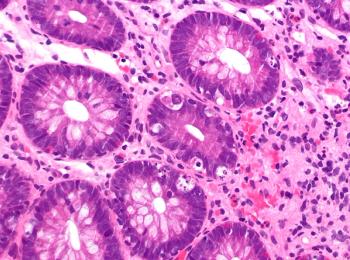
- Oncology Vol 28 No 4
- Volume 28
- Issue 4
Diffuse Large B-Cell Lymphoma: One Treatment No Longer Fits All
Rationally designed clinical trials investigating novel agents in patient populations enriched for those who are most likely to benefit will be instrumental for expediting progress. With respect to DLBCL, it has become clear that one treatment no longer fits all.
Significant progress in the management of diffuse large B-cell lymphoma (DLBCL) has been made within the last decade, and this has resulted in improved outcomes.[1-3] Although the majority of patients can be cured with R-CHOP (rituximab + cyclophosphamide, doxorubicin, vincristine, and prednisone), approximately 25% will relapse following an initial positive response, and an additional 10% to 15% will exhibit primary refractory disease, with progression or relapse within 3 months of therapy. This latter group represents the greatest challenge in DLBCL, since salvage therapy also proves ineffective.[4] The article by Dunleavy and Wilson[5] nicely summarizes recent advances in molecular insights that demonstrate the biologic diversity of DLBCL. More importantly, their article highlights not only the need to recognize this heterogeneity, but the promise of therapies that will exploit it.
The International Prognostic Index (IPI) stratifies patients according to clinical risk but fails to identify a “very poor outcome” group, since all IPI risk groups have at least a 50% chance of cure.[6] Strategies based on dose escalation for patients classified as “poor risk” according to the IPI will undoubtedly subject the majority in this group to needless toxicity. Moreover, simple dose escalation of cytotoxic agents in those who harbor chemotherapy resistance may only offer marginal benefit. In a recently reported North American intergroup trial, patients with high-intermediate–risk and high-risk IPI scores who were responding to R-CHOP were randomly assigned to either completion of treatment with standard chemotherapy or consolidation with high-dose chemotherapy and autologous stem cell transplantation.[7] While an improvement in progression-free survival with transplantation was observed, overall survival for the entire transplantation cohort was not improved. Going forward, tailoring therapy by selectively inhibiting recognized oncogenic drivers may be a more effective approach.
Gene expression profiling studies have demonstrated that DLBCL not otherwise specified (NOS) is comprised of at least two molecular subtypes-germinal center B-cell (GCB) and activated B-cell (ABC)-with approximately 15% of cases remaining unclassifiable.[8,9] These designations have prognostic significance, since the ABC subtype is associated with a poorer outcome following R-CHOP.[10] More importantly, the two subtypes are associated with different oncogenic mechanisms that promote their growth. The GCB subtype is associated with overexpression of genes involved in germinal center differentiation, such as EZH2 and BCL6, whereas the ABC subtype is associated with chronic active B-cell receptor signaling and the constitutive activation of the nuclear factor kappa B pathway. Based on these differences, it is anticipated that agents that selectively target components of these pathways will be preferentially beneficial in only one subtype. In fact, this has already been demonstrated, with drugs such as bortezomib, lenalidomide, and ibrutinib exhibiting selective benefit in the ABC subtype.[11-13]
A reliable method of identifying these molecular subtypes is required for clinical trials of targeted agents, and shortly will also be required for routine practice. Since gene expression profiling is not routinely available, and is currently not practical for prospective use within clinical trials, immunohistochemical algorithms have been developed to mimic gene expression profiling determination of these molecular designations. A recent comparative study suggested that the Tally algorithm, which utilizes five biomarkers (forkhead box protein P1 [FOXP1], centerin [GCET1], CD10, multiple myeloma oncogene 1 [MUM1], and LMO2), provided the greatest correlation.[14] However, these algorithms remain an imperfect substitute for gene expression profiling due to their inherent oversimplication and the poor reproducibility of immunohistochemistry. Still, while their prognostic value for individual patients remains unreliable, they may offer sufficient characterization to enable enrichment of a desired population in clinical trials. Ultimately, novel technologies using paraffin-embedded tissue, which offer greater accuracy and can provide detailed mutational analysis, will likely become widely available in the near future.[15]
In addition to molecular subtype, the relevance of MYC and BCL2 has recently been elucidated. Interestingly, while MYC and BCL2 can play a role in both the GCB and ABC subtypes, they may be largely responsible for the poorer prognosis seen in the ABC subgroup.[16] Approximately 10% of patients with DLBCL harbor a MYC translocation, but almost a third are found to overexpress MYC protein when this is measured by a newly available antibody.[17,18] Although studies have suggested that the presence of MYC is associated with a poorer outcome, it appears that the relevance of MYC is strongly influenced by a patient’s BCL2 status. Approximately 5% of patients with DLBCL have a dual translocation of MYC and BCL2, so called “double-hit” lymphoma, which results in aggressive refractory disease and a median survival of less than one year. A larger cohort, approximately 20% of patients, overexpress MYC and BCL2 proteins, and have long-term disease-free survival in the range of 25%, which is significantly worse than that of patients who express only one or neither protein.[17,18] Due to the markedly poor outcomes observed in patients with double-hit lymphoma, these patients should be strongly considered for alternate therapies. Reports of intensive induction followed by consolidation with transplantation suggest an improvement in outcome.[19,20] Alternative strategies in patients with dual expression of MYC and BCL2 are also warranted; however, these should be tried within the context of clinical trials where the measurement of MYC and BCL2 might be standardized. Ultimately, this last subset of patients would be ideally suited for trials of novel agents that specifically target MYC and BCL2.
The comprehensive review by Dunleavy and Wilson serves to illustrate the complexity of DLBCL, as well as the potential for selectively targeting key components within the oncogenic cascade. Rationally designed clinical trials investigating novel agents in patient populations enriched for those who are most likely to benefit will be instrumental for expediting progress. With respect to DLBCL, it has become clear that one treatment no longer fits all.
Financial Disclosure:Dr. Sehn serves as a consultant to and receives honoraria from Amgen, Celgene, Janssen, Lundbeck, and Roche/Genentech.
References:
1. Coiffier B, Lepage E, Briere J, et al. CHOP chemotherapy plus rituximab compared with CHOP alone in elderly patients with diffuse large-B-cell lymphoma. N Engl J Med. 2002;346:235-42.
2. Habermann TM, Weller EA, Morrison VA, et al. Rituximab-CHOP versus CHOP alone or with maintenance rituximab in older patients with diffuse large B-cell lymphoma. J Clin Oncol. 2006;24:3121-7.
3. Pfreundschuh M, Trumper L, Osterborg A, et al. CHOP-like chemotherapy plus rituximab versus CHOP-like chemotherapy alone in young patients with good-prognosis diffuse large-B-cell lymphoma: a randomised controlled trial by the MabThera International Trial (MInT) Group. Lancet Oncol. 2006;7:379-91.
4. Hitz F, Connors J, Gascoyne R, et al. Outcome of patients with chemotherapy refractory and early progressive diffuse large B cell lymphoma after R-CHOP treatment. Blood; ASH Annual Meeting Abstracts. 2010;116:Abstr 1751.
5. Dunleavy K, Wilson WH. Appropriate management of molecular subtypes of diffuse large B-cell lymphoma. Oncology (Williston Park). 2014;28:326-34.
6. Ziepert M, Hasenclever D, Kuhnt E, et al. Standard International prognostic index remains a valid predictor of outcome for patients with aggressive CD20+ B-cell lymphoma in the rituximab era. J Clin Oncol. 2010;28:2373-80.
7. Stiff PJ, Unger JM, Cook JR, et al. Autologous transplantation as consolidation for aggressive non-Hodgkin's lymphoma. N Engl J Med. 2013;369:1681-90.
8. Alizadeh AA, Eisen MB, Davis RE, et al. Distinct types of diffuse large B-cell lymphoma identified by gene expression profiling. Nature. 2000;403:503-11.
9. Rosenwald A, Wright G, Chan WC, et al. The use of molecular profiling to predict survival after chemotherapy for diffuse large-B-cell lymphoma. N Engl J Med. 2002;346:1937-47.
10. Lenz G, Wright G, Dave SS, et al. Stromal gene signatures in large-B-cell lymphomas. N Engl J Med. 2008;359:2313-23.
11. Dunleavy K, Pittaluga S, Czuczman MS, et al. Differential efficacy of bortezomib plus chemotherapy within molecular subtypes of diffuse large B-cell lymphoma. Blood. 2009;113:6069-76.
12. Hernandez-Ilizaliturri FJ, Deeb G, Zinzani PL, et al. Higher response to lenalidomide in relapsed/refractory diffuse large B-cell lymphoma in nongerminal center B-cell-like than in germinal center B-cell-like phenotype. Cancer. 2011;117:5058-66.
13. Wilson W, Gerecitano J, Goy A, et al. The Bruton’s tyrosine kinase (BTK) inhibitor, ibrutinib (PCI-32765), has preferential activity in the ABC subtype of relapsed/refractory de novo diffuse large B-cell lymphoma (DLBCL): interim results of a multicenter, open-label, phase 2 study. Blood; ASH Annual Meeting Abstracts. 2012;120:Abstr 686.
14. Meyer PN, Fu K, Greiner TC, et al. Immunohistochemical methods for predicting cell of origin and survival in patients with diffuse large B-cell lymphoma treated with rituximab. J Clin Oncol. 2011;29:200-7.
15. Scott D, Wright G, Williams M, et al. Determining cell-of-origin subtypes in diffuse large B-cell lymphoma using gene expression profiling on formalin-fixed paraffin-embedded tissue – an L.L.M.P.P. Project. Blood; ASH Annual Meeting Abstracts. 2013;122:Abstr 73.
16. Hu S, Xu-Monette ZY, Tzankov A, et al. MYC/BCL2 protein coexpression contributes to the inferior survival of activated B-cell subtype of diffuse large B-cell lymphoma and demonstrates high-risk gene expression signatures: a report from The International DLBCL Rituximab-CHOP Consortium Program. Blood. 2013;121:4021-31.
17. Green TM, Young KH, Visco C, et al. Immunohistochemical double-hit score is a strong predictor of outcome in patients with diffuse large B-cell lymphoma treated with rituximab plus cyclophosphamide, doxorubicin, vincristine, and prednisone. J Clin Oncol. 2012;30:3460-7.
18. Johnson NA, Slack GW, Savage KJ, et al. Concurrent expression of MYC and BCL2 in diffuse large B-cell lymphoma treated with rituximab plus cyclophosphamide, doxorubicin, vincristine, and prednisone. J Clin Oncol. 2012;30:3452-9.
19. Gandhi M, Petrich A, Cassaday R, et al. Impact of induction regimen and consolidative stem cell transplantation in patients with double hit lymphoma (DHL): a large multicenter retrospective analysis. Blood; ASH Annual Meeting Abstracts. 2013;122:abstr 640.
20. Sun H, Savage K, Karsan A, et al. Outcome of patients with double-hit lymphomas treated with CODOX-M/IVAC + R followed by hematopoietic stem cell transplantation in British Columbia. Blood; ASH Annual Meeting Abstracts. 2013;122:Abstr 1788.
Articles in this issue
over 11 years ago
HER2-Positive Breast Cancer: The Story Goes Onover 11 years ago
Diffuse Large B-Cell Lymphoma: Changing Treatment Paradigmsover 11 years ago
Large Renal Mass: A Challenge for the UrologistNewsletter
Stay up to date on recent advances in the multidisciplinary approach to cancer.

















































































